The UL standard for household coffee makers is: UL 1082 - "Standard for Household Electric Coffee Makers and Brewing-Type Appliances". Edition 6 was published in March of 2009; it cost over $700. I was able to find and download an older version of the standard on the Internet for free. For drip coffee makers, UL 1082 requires a limiting-type device. The usual limiting device is a thermal cutoff. It is easier to meet the specifications if two thermal cutoffs are used. All of the drip coffee makers I have examined had two thermal cutoffs. UL 1082 refers you to UL 1020: "Standard for Thermal Cutoffs for Use in Electrical Appliances and Components".
This section uses the terms: Thermal Fuse, Thermal Cutoff (TCO) and Thermal Cutout (TCO) for the same device.
NEC/Schott Thermal Fuses Brochure
Emerson/Thermodisc Microtemp Thermal Fuse Bulletin 091613
For coffee maker enclosures, UL 1082 refers you to UL 746A: "Polymeric Materials - Short Term Property Evaluations" and UL 746C: "Standard for Polymeric Materials - Used in Electrical Equipment Evaluations". These standards are concerned with a material's ability to resist ignition from electrical sources. Both UL 746A and UL 746C reference UL 94: "Standard for Safety of Flammability of Plastic Materials for Parts in Devices and Appliances testing".
Mr. Coffee, Pioneer of the Home Drip Coffee Maker
In 1972, Mr. Coffee introduced the first drip coffee maker for the home. The first models were gravity fed. Later models used a single heating element under the warmer plate as thermo-syphon to lift the water from a reservoir into the brewing basket. Gravity then pulled the hot water through the coffee grounds and paper filter into a carafe below. The result was a more uniform brewing temperature (200°F) and a better flavored coffee. In 1973, the legendary baseball player Joe DiMaggio became the national spokesperson for Mr. Coffee. By 1975, nearly 38,000 Mr. Coffee machines were being sold a day. In 1979, Mr. Coffee started adding timers, so you could wake up to a fresh brewed pot of coffee. Mr. Coffee held approximately 50 percent of the market share into the late 1970's.
Prior to 1972, most home coffee makers were percolators.
2. A Brief History of At-Home Coffee Brewing
3. Here's to Mr. Coffee, Known to Some as Sam - New York Times
4. Mr. Coffee, Inc. History - Fundinguniverse
1990 Proctor-Silex Recall of Drip Coffeemakers Made In 1985-1986:
In 1990, Proctor-Silex in cooperation with the U.S. Consumer Product Safety Commission recalled certain automatic drip coffeemakers made in 1985/86 that may pose a fire hazard. The thermostats and thermal fuses may both malfunction causing overheating and a potential fire hazard. Approximately 181 reports of fires have been received. When the recall was issued, it was estimated that 800,000 of these coffeemakers were still in use.
CPSC 1990 Recall of Proctor-Silex Drip Coffeemakers
1991 GE Recall, Law Suit and Defective Thermal Cutoffs (TCO's):
In 1991, nine million drip coffee makers bearing the GE or Universal name were recalled. The coffee makers were manufactured between 1976 and 1984. The safety thermal cutoffs (TCO) used in the coffee makers were not reliable [1]. The U.S. Consumer Product Safety Commission (CPSC) sued GE for not reporting the problem in a timely manner as required by law. GE received more than 500 reports of the coffee makers overheating. The TCO failures may have been responsible for fires that resulted in a number of deaths and serious personal injuries [2].
In 1982, GE designed a coffee maker with two TCO's, but the coffee maker never went into production. GE continued to manufacturer the one TCO design. In 1984, when the small appliance division of GE was sold to Black and Decker, the design was changed to two TCO's [3].
1. CPSC 1991 Recall of GE Drip Coffeemakers
2. CPSC Lawsuit Settlement against GE
3. Total Recall: Haunting Memories Drive Utahan to push for Protective Measures
I don't know how many times I have heard other engineers say that Mr. Coffee was sued so many times, they were forced to include two thermal cutoffs. I believe that this was because of Mr. Coffee's name recognition and the real culprits were Protor-Silex and GE.
If the specifications in UL 1082 and UL 1020 are met then a single thermal cutoff can be used. However, it is usually more economical to meet the specification for two thermal cutoffs. I started examining coffee makers in 1997. Every drip coffee maker I have examined had two thermal cutoffs in series.
Case History: Exemplar Mr. Coffee, Drip, 4 Cup, Coffee Maker Purchased at Wal-Mart in 2006 for $19.94.
For Maximum Resolution, Click on the Body of the Picture.
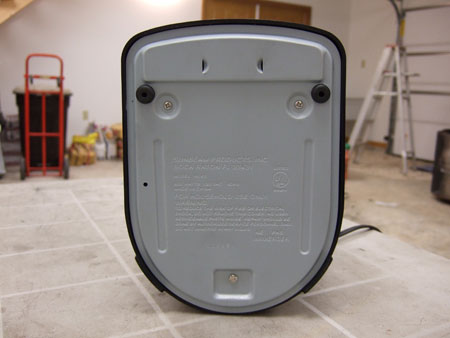
The Manufacturer's Data is Stamped into the Bottom Plate
of the Coffee Maker. Mr. Coffee is Owned by Sunbeam.
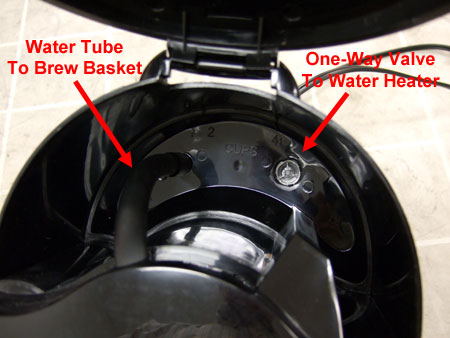
Water Leaves the Reservoir Through the One-Way Valve and Enters
the Heating Tube. Boiling Bubbles Push the Water into the Brew Basket.
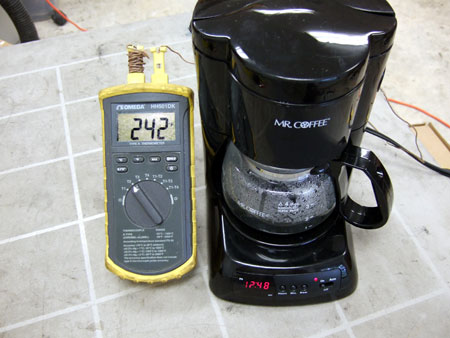
Brew Heating Tube Temperature: 242 °F. Warmer Heating Tube
Temperature: 260-313 °F. Duty Cycle: ON = 10 sec.; OFF = 127 sec.
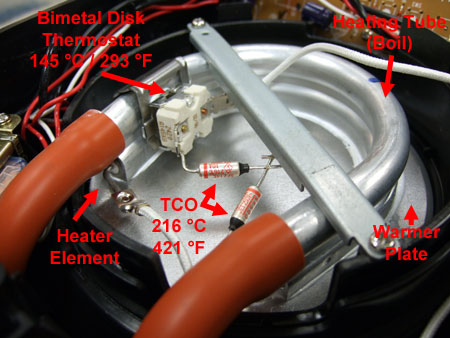
The Water in the Heating Tube Starts to Boil, and a Column of Water
rides Upward on Top of the Bubbles to the Brew Basket.

Bottom of Coffee Maker. The 12 VAC Transformer Supplies Power to
the Clock/Timer, and the Relay Switches.
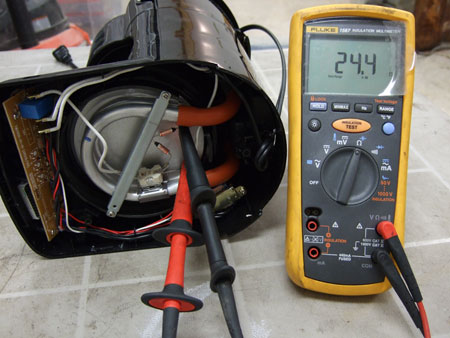
Measured Resistance of Heating Element: 24.4 Ω.
Using 24.4 Ohms, the Calculated Wattage is 590 Watts.
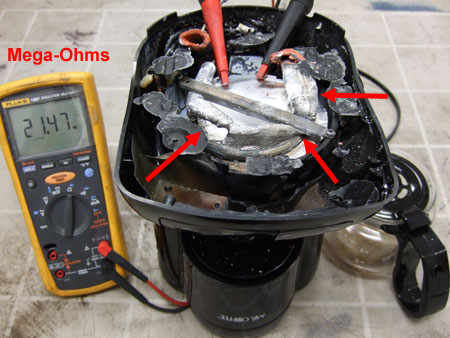
Test with Thermostat and Cutoffs Removed. The Aluminum Heating
Tube Melted and the Heating Element Opened.
Case History: Evidence Examination Case #: F06-026.
For Maximum Resolution, Click on the Body of the Picture.

Both the Water Heating Tube and the Heater Element were Intact.
Measured Heater Element Resistance: 24.2 Ω.
Case History: Evidence Examination Case #: F14-027.
This Mr. Coffee coffeemaker does not have a warmer plate. The coffee is kept warm by a stainless steel thermal carafe (double-wall, vacuum-insulated). The water is quickly heated up to 205°F by a flash heating chamber (1300 watts). The coffeemaker has a water filltration system that removes up to 97% of the chlorine. A proximity sensor prevents the coffemaker from brewing unless the metallic carafe is in place.
For Maximum Resolution, Click on the Body of the Picture.